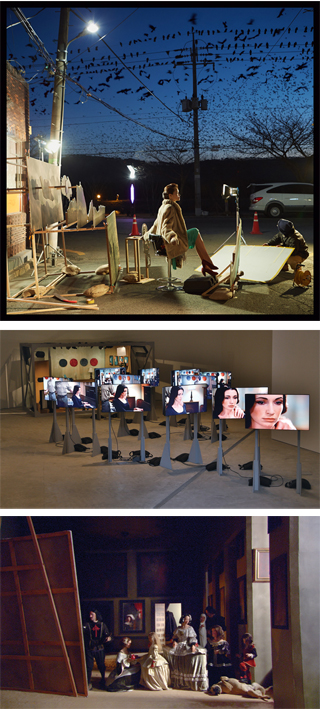Mise-en-scenes break barrier between film and stills

From the top: Jung Yeondoo’s photo “The Bird B-Camera,” Adad Hannah’s video installation “Half a Second,” and a still from Eve Sussman and Rufus Corporation’s film “89 Seconds at Alcazar” are part of the “Mise-En-Scene” exhibition that starts tomorrow at Leeum. Provided by the museum
In the 20th century, Avant-Garde artists took liberal creative license, but the post-modern era has seen a return to the original figurative forms of older masters and a closer relationship with mise-en-scene from films.
An exhibition exploring such work starts at Leeum, Samsung Museum of Art tomorrow.
“A mise-en-scene is used to refer to the elements of visual composition in a film scene,” explained Koo Kyung-hwa, curator of the exhibition. “A mise-en-scene in a movie, as a tool for advancing a story, can contain a rich array of meanings even without spoken lines or editing. This exhibition explores fine art utilizing the cinematic technique.”
The exhibition starts with Canadian artist Adad Hannah’s video installation “Half A Second” (2013). In this work, a scene from “The Housemaid” (1960), known as one of the most eccentric Korean movies, is reproduced with actors employed by the artist. The scene is divided into 12 images on 12 monitors along which viewers walk to see each part.
As one second of a film is made up of 24 frames, “Half A Second” consists of 12 images. And unlike the real film frames that are still, the images show delicate movement, making viewers focus more intensely and imagine a narrative. But the last image reveals that the work is just part of a directed scene - not reality - by showing the set complete with lighting and production crews.
In this way, Hannah’s work shows film scenes’ power to enthrall the audience with real and fictional qualities at the same time.
While the work deconstructs a movie scene, the short film “89 Seconds in Alcazar” by British-born American artist Eve Sussman and the cooperative artist group Rufus Corporation deconstructs the painting “Las Meninas”(1656) by Spanish master Diego Velazquez in terms of time.
In the 10-minute film, Sussman portrays the things that she imagines happened before and after the moment captured in the painting with an elaborate lighting set to resemble that in Baroque paintings.
Through this technique, she spreads the passage of time that was condensed into the painting and adds her own interpretation.
Korean artist Jung Yeondoo’s “Plan B” series show three pairs of photos that reproduce the highly recognizable scenes of three movies, including Alfred Hitchcock’s “The Birds.” Each pair consists of a reproduced image of the movie scene and a photo showing the reproduction process.
The photos reveal that the reproduced images were taken in places where reality overwhelms fiction. A scene from Yasujiro Ozu’s “Tokyo Story” was reproduced in Fukushima, Japan, the site of the nuclear disaster that followed the tsunami in 2011. And a scene from Kang Je-gyu’s “Taegukgi: The Brotherhood of War” was reproduced in the tense Demilitarized Zone between the two Koreas.
“My real intention is to make viewers interested in famous movies scenes see the reality overwhelming the movies in the opposite way that people interested in a real incident go see a movie based on it,” the artist said in a press preview on Monday.
The exhibits also include photography by Thomas Demand of Germany and Gregory Crewdson of the United States. Other participants are the Russian artist group AES+F, Chinese cinematographer and photographer Yang Fudong, and Korean sculptor and installation artist Zin Kijong.
The exhibition runs through June 2. Admission is 7,000 won ($6.30) for adults. A day pass including admission to the permanent exhibitions is 13,000 won. Hours are 10:30 a.m. to 6 p.m. Tuesday to Sunday. Go to Hangangjin Station, line No. 6, exit 1 and walk five minutes. For details, call (02) 2014-6900, or visit www.leeum.org.
By Moon So-young [symoon@joongang.co.kr]










with the Korea JoongAng Daily
To write comments, please log in to one of the accounts.
Standards Board Policy (0/250자)